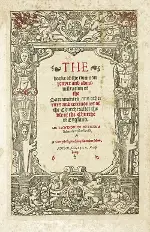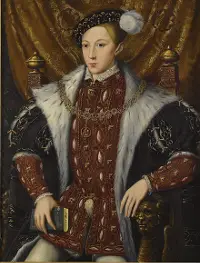King Edward VI of England
Edward VI ruled England for a short time but oversaw a handful of long-lasting fundamental changes in the way that people lived and worshiped. 
Edward was born on Oct. 12, 1537, at Greenwich. His father was King Henry VIII, and his mother was Henry's third wife, Jane Seymour, who died 12 days after her son was born. Edward was Henry's long-sought-after male heir; and as such, the young boy enjoyed a lavish amount of attention. Various women at court stepped in to take the place of his mother in rearing him, including Margaret Bryan, Blanche Herbert, and Henry's last wife, Catherine Parr, who took an active role in helping Edward grow and learn. He also had a handful of tutors, including John Cheke and Richard Cox, to help him learn the arts of statesmanship and all manner of subjects. Edward was intelligent and thoughtful and soon mastered French, German, Greek, and Latin and enjoyed a thorough understanding of geography and history. Not content to stay indoors, he also excelled at fencing, horseback riding, and jousting. He kept a journal and wrote of all of these things. Henry died on Jan. 28, 1547, when Edward was 9. Edward was technically king and was so crowned on February 20; but because he was so young, Edward ceded most of the real decision-making to two men in succession, the Duke of Somerset and the Duke of Northumberland. Somerset was Edward Seymour, the young king's uncle and was named Lord Protector. Another uncle, Thomas Seymour, was Lord Admiral, part of the Council of Regency, which comprised more than a dozen officials who performed the various functions of government. Thomas Seymour proved to be much more scheming than his brother and much more of a scoundrel than the king would have wanted. Edward had him charge with treason and executed. 
Henry VIII had declared himself the head of the Church in England and, technically, broken away from the Catholic Church. Somerset and Archbishop of Canterbury Thomas Cranmer wanted to take that action one step further and make England a Protestant nation. They convinced Parliament to pass an Act of Uniformity in 1549 that allowed for an English Prayer Book and required English people to use it in their worship. Among other things, the Act allowed the clergy in England to marry. Edward approved other changes to the ways in which English worshiped and even the places in which they worshiped. For example, he ordered stained glass windows removed from churches and altars replaced with unadorned tables. Significantly, the changes also included the abolition of the Catholic Mass and the advent of Holy Communion; in effect, this change represented a difference in the way what the religious ceremony signified. Many people in England at this time still professed the Catholic faith. Others also distrusted such actions, fearing that too much change might incite the wrath of other countries. One pointed reaction to the Act of Uniformity was a rebellion by a large number of people in Cornwall and Devon, who refused to promise to abide by the new English Prayer Book. At the same time, a number of people in Norfolk refused to obey the government's rules regarding the allocation of land and took up arms against the government. In yet another challenge to the young king's reign, France, confirming the fears of many English conservatives, declared war on England. Somerset had spent considerable time early in Edward's reign building up a strong military presence in Scotland, building forts and winning a battle or two. It was likely no coincidence that France chose such a moment to invade southern England. The French king, Henry II, had offered his young son as a marriage match for the young Scottish queen, Mary. Scotland accepted this alliance, and French troops arrived in Scotland to help relieve an English siege. The fighting stopped in 1551. Somerset proved unable to solve the rebellion of the Norfolk land; John Dudley, the Earl of Warwick, came to the rescue, putting down the uprising led by tradesman Robert Kett. The Regency Council blamed Somerset for all of the upheaval and had him arrested. Not long afterward, Dudley took over the running of the government, after being named Duke of Northumberland. This prime king's representative wasn't any more successful in foreign affairs than Somerset had been, and England was forced to sign a peace treaty with France. 
In 1553, Edward, who had suffered from a weak constitution for most of his life, became ill. He had nearly died more than once when he was very young, including a simultaneous bout with measles and smallpox. This time, he was believed to have contracted tuberculosis. He made his final public occurrence on July 1, appearing thin and weak, and died five days later, at Greenwich Palace. He was 15. In his will, Edward had declared his wishes that his successor on the throne of England be not either of his half-sisters, Mary and Elizabeth, but his first cousin, the Lady Jane Grey. She survived for nine days as the nominal leader before she was deposed by the next crowned monarch, who became Mary I. |
|
Social Studies for Kids
copyright 2002–2026
David White




